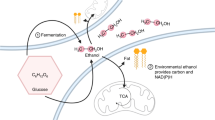Abstract.
The hyperthermophilic, sulfate-reducing archaeon Archaeoglobus fulgidus strain 7324, rather than the type strain VC16, was found to grow on starch and sulfate as energy and carbon source. Fermentation products and enzyme activities were determined in starch-grown cells and compared to those of cells grown on lactate and sulfate. During exponential growth on starch, 1 mol of glucose-equivalent was incompletely oxidized with sulfate to approximately 2 mol acetate, 2 mol CO2 and 1 mol H2S. Starch-grown cells did not contain measurable amounts of the deazaflavin factor F420 (<0.03 nmol/mg protein) and thus did not show the F420-specific green-blue fluorescence. In contrast, lactate (1 mol) was completely oxidized with sulfate to 3 mol CO2 by strain 7324, and lactate-grown cells contained high amounts of F420 (0.6 nmol/mg protein). In extracts of starch-grown cells, the following enzymes of a modified Embden-Meyerhof pathway were detected: ADP-dependent hexokinase (ADP-HK), phosphoglucose isomerase, ADP-dependent 6-phosphofructokinase (ADP-PFK), fructose-1,6-phosphate aldolase, glyceraldehyde-3-phosphate:ferredoxin oxidoreductase (GAP:FdOR), phosphoglycerate mutase, enolase, and pyruvate kinase (PK). Specific activities of ADP-HK, ADP-PFK, GAP:FdOR, and PK were significantly higher in starch-grown cells than in lactate-grown cells, indicating induction of these enzymes during starch catabolism. Pyruvate conversion to acetate involved pyruvate:ferredoxin oxidoreductase and ADP-forming acetyl-CoA synthetase. The findings indicate that the archaeal sulfate reducer A. fulgidus strain 7324 converts starch to acetate via a modified Embden-Meyerhof pathway and acetyl-CoA synthetase (ADP-forming). This is the first report of growth of a sulfate reducer on starch, i.e. on a polymeric sugar.
Similar content being viewed by others
Author information
Authors and Affiliations
Additional information
Electronic Publication
Rights and permissions
About this article
Cite this article
Labes, A., Schönheit, P. Sugar utilization in the hyperthermophilic, sulfate-reducing archaeon Archaeoglobus fulgidus strain 7324: starch degradation to acetate and CO2 via a modified Embden-Meyerhof pathway and acetyl-CoA synthetase (ADP-forming). Arch Microbiol 176, 329–338 (2001). https://doi.org/10.1007/s002030100330
Received:
Revised:
Accepted:
Issue Date:
DOI: https://doi.org/10.1007/s002030100330




